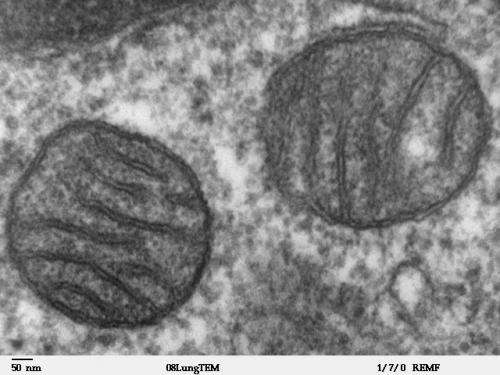March 8, 2016 report
Researchers report cell-to-cell movement of mitochondria through a graft junction of two plant species

(Phys.org)—A team of researchers with Rutgers University has found an example via experimentation, of cell-to-cell movement of mitochondria through a graft junction of two tobacco species. In their paper published in Proceedings of the National Academy of Sciences, the team describes their experiments with grafting tobacco plants and what they learned about cells swapping mitochondria during the aftermath.
Human beings have been grafting plants for centuries, cutting a branch from one plant and pressing it against an exposed part of another has resulted in fruit trees that bear more than one type of fruit, for example. But, what has not been clear is what else happens during grafting—to the human eye it appears a grafted branch produces the type of fruit it originally would have, but not much else. But genetic research over the past decade has shown that chloroplasts can be exchanged between cells on either side of a graft, and in some cases an entire cell nucleus can be exchanged as well. In this new effort, the researchers have found that cells can exchange mitochondria also which means that plants mix their DNA together when grafting takes place.
To find out more about what happens during grafting the researchers grafted one species of tobacco plant onto another, one of which had a mutation that prevented male flowers from growing in a normal way. Next, they sliced off pieces of the plant from the side of the graft that had come from a male sterile plant and planted it resulting in new plants growing individually from the ground. As those plants grew, the researchers found that some of them developed normal male flowers, which showed that mitochondrial transfer had occurred between the two species. When the team looked at the mitochondrial genomes of the plants, they found recombination of the two and were also able to identify the gene that was likely responsible for the male sterility.
This new evidence blurs the line between genetically modified plants, or crops that come about due to man-made processes and those that occur naturally, because natural grafting sometimes occurs when two plants grow close to one another. Those who insist that GMOs are harmless will now have another argument to back them up because it now appears that plants have been swapping DNA naturally all along.
More information: Csanad Gurdon et al. Cell-to-cell movement of mitochondria in plants, Proceedings of the National Academy of Sciences (2016). DOI: 10.1073/pnas.1518644113
Abstract
We report cell-to-cell movement of mitochondria through a graft junction. Mitochondrial movement was discovered in an experiment designed to select for chloroplast transfer from Nicotiana sylvestris into Nicotiana tabacum cells. The alloplasmic N. tabacum line we used carries Nicotiana undulata cytoplasmic genomes, and its flowers are male sterile due to the foreign mitochondrial genome. Thus, rare mitochondrial DNA transfer from N. sylvestris to N. tabacum could be recognized by restoration of fertile flower anatomy. Analyses of the mitochondrial genomes revealed extensive recombination, tentatively linking male sterility to orf293, a mitochondrial gene causing homeotic conversion of anthers into petals. Demonstrating cell-to-cell movement of mitochondria reconstructs the evolutionary process of horizontal mitochondrial DNA transfer and enables modification of the mitochondrial genome by DNA transmitted from a sexually incompatible species. Conversion of anthers into petals is a visual marker that can be useful for mitochondrial transformation.
Journal information: Proceedings of the National Academy of Sciences
© 2016 Phys.org



















